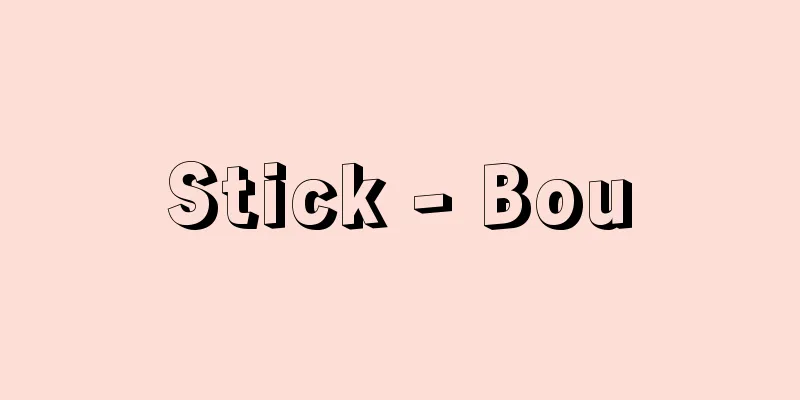Stick - Bou

|
For a very long period in human history, sticks accounted for the majority of wood materials used by humans. In the Stone Age, felling large diameter trees and shaping large volumes of lumber was difficult. Even in the Metal Age, until the technology for manufacturing tools (especially saws) developed and the lumber market improved, common people could not obtain and shape large volumes of lumber, and they usually used sticks made from easily available branches and small tree trunks for various purposes. A considerable portion of the world's peoples lived in dwellings that combined frameworks made of long sticks tied together with ropes with easily available materials such as mud, stones, twigs, and dried grass, and ate food heated by burning the raw materials for making sticks and other foods in pottery fired with the same fuel because it was difficult to use large diameter lumber and large amounts of firewood. From the very beginning of tools that advanced human culture, to standardized tools for striking (hammers), cutting (knives, axes, etc.), scraping (chisels, sharp axes, etc.), drilling (awls, etc.), and holding (scissors, etc.), the part to be held in the hand was generally made from a stick. Digging sticks (bean planting sticks, etc.), based on a type with a heated pointed part and donut-shaped weight stones on both ends, seed beaters (handling chopsticks, bean beating sticks, etc.), and cooking sticks (kneading sticks, pestles, etc.) emerged from gatherer cultures, while rod-shaped farm tools with blades such as hoes, hoes, and sickles were added in agricultural cultures. Clubs, spears, swords, harpoons, arrows and other rod-shaped tools with blades, as well as traps made from sticks, were developed as hunting and fishing tools and weapons. The cattle walking stick used for pasturing livestock, which was also used as a religious symbol, is probably a variation of a club or spear without a point. Other important rod-shaped tools include beating sticks used to adjust materials for textile products such as leather and straw, as well as the textile products themselves, spindles for spinning thread, and shuttles for weaving cloth. Digging sticks, which were used to transport food obtained by hunting and gathering, and sticks for transporting goods on land, originally modelled on spears, were developed in areas where cars were not yet developed, and in Japan idioms such as "botefuri," a pole used in small-scale business using a balance balance, and "sakibo katsugi," a pole used to determine the direction of a palanquin (vehicle) were born. The stick, a divine symbol held by religious rulers, was an important fetish in many institutional and state religions, including the religion of ancient Egypt. Many cultures considered the stick to have a special meaning as a symbol of masculinity, and used it in fertility rituals. In Japan, prehistoric stone sticks are thought to have sexual symbolism, and in folklore, the various celebratory sticks used in Little New Year ceremonies (such as the bride-beating stick and the rice porridge-stirring stick) are believed to have similar sexual magical powers. [Akira Sasaki] [References] | | | | |Source: Shogakukan Encyclopedia Nipponica About Encyclopedia Nipponica Information | Legend |
|
人類史上の非常に長い期間にわたり、棒は人間の用いた木質素材の大部分を占めた。大直径樹木の伐採と大体積木材の成形は石器時代には困難であった。金属器時代に入っても、加工用具(とくに鋸(のこぎり))の製造技術が発達し、材木市場が充実するまでは、大体積木材の取得、成形には庶民の手が届かず、得やすい枝、小さな木の幹に手を加えた棒を多目的に利用するのが普通だった。世界の諸民族の少なからぬ部分が、長い棒を縄で縛り合わせた骨組と泥、石、小枝、枯れた草などの入手の容易な素材を組み合わせた住居に住み、棒の原料などを燃やして加熱した食物を同じ燃料で焼成した土器で食べたのは、大直径の材木、大量の薪(まき)を利用しにくかったからである。人類の文化を発展させた道具はその発生から、たたく(槌(つち)類)、切る(ナイフ、斧(おの)など)、削る(鑿(のみ)、丁斧(ちょうな)など)、穴あけ(錐(きり)など)、押さえる(鋏(はさみ)類)などの定型化した道具に至るまで、手でつかむ部分を棒でつくるのが原則だった。加熱処理した尖頭(せんとう)部とドーナツ型重り石をつける部分を両端とするタイプを原型とする「掘棒(ほりぼう)」(豆植え棒など)、シードビーター(扱箸(こきばし)、豆打ち棒など)、調理用の棒(こね棒、すりこぎなど)は採集文化から出現し、農耕文化では鍬(くわ)、鋤(すき)、鎌(かま)などの刃をつけた棒状農具が加わった。棍棒(こんぼう)、槍(やり)、刀剣、銛(もり)、矢などの刃をつけた棒型具、棒を利用したわな類は狩猟・漁労用具、武器として発達した。宗教的象徴にも利用された牧畜用の杖(つえ)は、棍棒または尖頭器のない槍の変形だろう。皮革、藁(わら)などの繊維製品材料や繊維製品自体を調整するたたき棒、糸を紡ぐ錘(つむ)、織布用の梭(ひ)なども重要な棒状用具である。採集狩猟で得た食糧も運んだ掘棒、槍を原形とする陸上運搬用の棒は、車の発達しなかった地域では発達し、日本では天秤(てんびん)棒を用いた零細商業の「棒手振(ぼてふ)り」、駕籠(かご)(乗り物)の進行方向を決める「先棒かつぎ」などの慣用句が生まれた。 宗教的支配者が手にした神権的象徴としての棒は、古代エジプトの宗教をはじめとする多数の制度的・国家的宗教の重要呪物(じゅぶつ)だった。男性の象徴としての棒に特別な意味を考え、増産儀礼に用いる文化も少なくなかった。日本では、先史時代の石棒に性的象徴性が予想され、民俗例では小(こ)正月行事に用いる多様な祝い棒(嫁打ち棒、粥掻(かゆかき)棒など)に同様の性的呪力があるとされた。 [佐々木明] [参照項目] | | | | |出典 小学館 日本大百科全書(ニッポニカ)日本大百科全書(ニッポニカ)について 情報 | 凡例 |
Recommend
《Guide to entertaining》 - Guide for entertaining
…He grew up in a wealthy family, with his grandfa...
Locksmith - Kagiya
During the Edo period, the company was a pioneer ...
Minehama [village] - Minehama
A village in Yamamoto County, northwest of Akita P...
Uranometria Nova (English spelling)
…He was the first director of the Bonn Observator...
Mitsui Hachiroemon
The hereditary name that represents the Mitsui fam...
Koushin faith - Koushinshinko
It is a religious event held on the day of the Ko...
Additional fee - additional fee
…This was linked to the incentive of granting tax...
"Kawasumi Taikoki" - I want to dodge
…Collected in the Revised Collection of Historica...
Hitting pattern - Uchie
〘Noun〙 In order to prevent the handles of spears, ...
Jacobinism
During the French Revolution, this ideology was ma...
Kaizuihikan - Kaizuihikan
…When he was governor of Yingtian, he was dismiss...
Rent according to ability - Ounouyachin
… On the other hand, when looking at rent from th...
Method of population estimation
Just as population statistics are one of the basic...
Chinzei Discussion Hall - Chinzei Discussion Hall
In 1286 (Kōan 9) after the Mongol invasion, the K...
Lake - Mizuumi
〘Noun〙 (meaning "sea of water") A lake...









